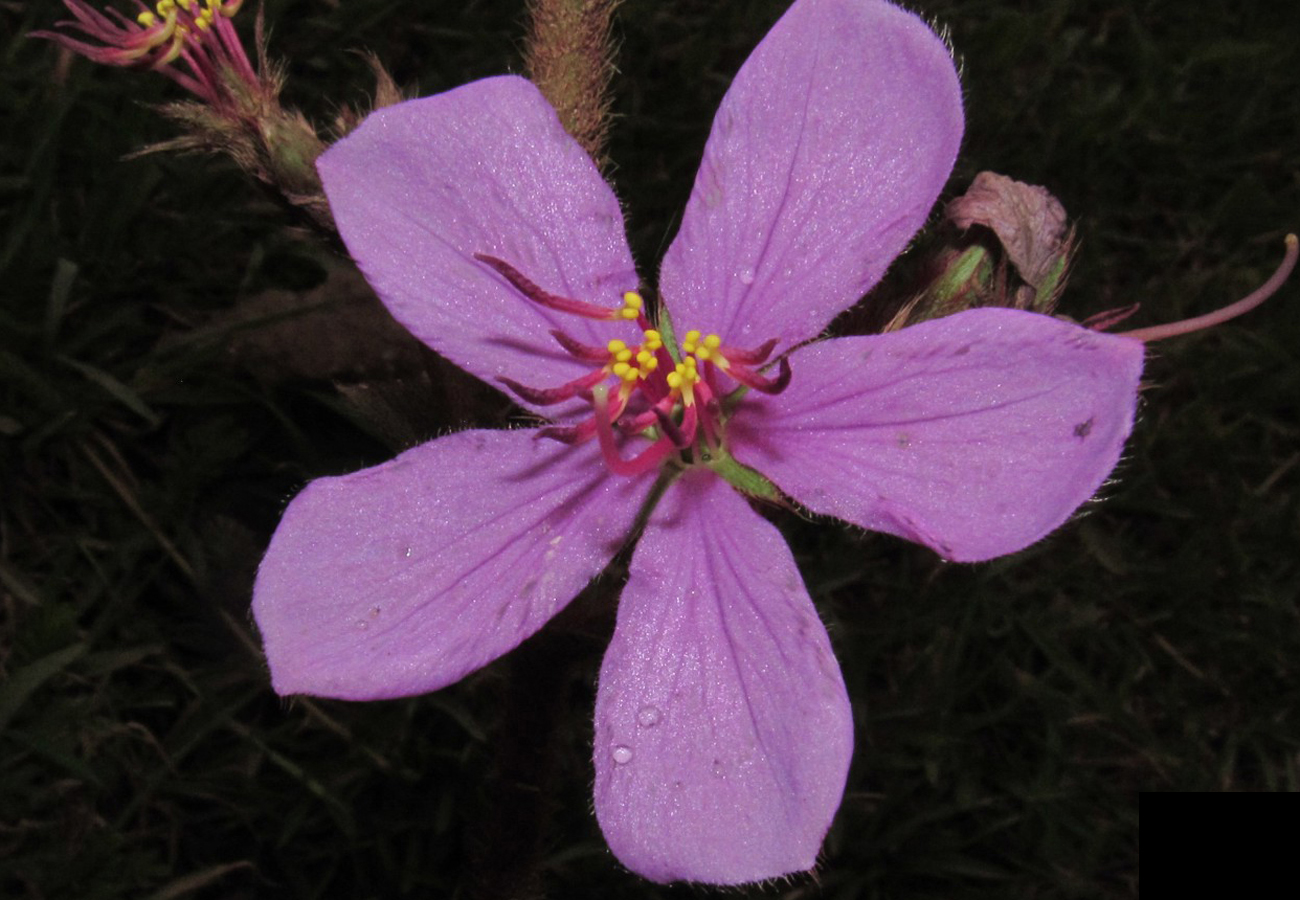Abstract
Eleven varieties of Tibouchina gracilis were indicated as synonyms of Chaetogastra gracilis in the most recent work on the taxonomy of the genus. However, field observations and a more detailed analysis of herbarium specimens, including the types, led us to the conclusion that two of these varieties represent a single new species. Chaetogastra cogniauxiana is endemic to Brazil, and differs from C. gracilis by the smaller size, 10–70 cm tall (versus 30–120 cm tall in C. gracilis), dendritic-setose to dendritic-strigose hypanthium and bracteoles (vs. dendritic-sericeous hypanthium and bracteoles), and smaller petals, 9.8–13.4 × 8.8–9.1 mm (vs. larger petals, 16.5–21.6 × 11.2–14.8 mm). In this article, we provide a complete description of C. cogniauxiana, and indicate the main morphological differences between C. cogniauxiana and the most closely related species. We also provide comments on taxonomy and phylogenetic relationships of this species, photos, illustrations, and a distribution map. This work is part of a monograph of the genus Chaetogastra in Brazil, which showed a great species richness and also the necessity of several taxonomic adjustments.
References
Bachman, S., Moat, J., Hill, A.W., Dela Torre, J. & Scott, B. (2011) Supporting Red List threat assessments with GeoCAT: Geospatial conservation assessment tool. ZooKeys 150: 117–126. https://doi.org/10.3897/zookeys.150.2109
Bartling, F.G. (1830) Ordines naturales plantarum eorumque characteres et affinitates; adjecta generum enumeratione. Dieterich, Göttingen, 498 pp.
Chamisso, A. (1834) De Plantis in Expedition Speculatoria Romanzoffiana et in Herbariis Regiis Berlolinensibus observatis dicere pergit. Linnaea 9: 428–460.
Cogniaux, A.C. (1885) Melastomataceae. In: Martius, C.F.P., Eichler, A.G. & Urban, I. (Eds.) Flora Brasiliensis, vol. 14 (3). Lipsiae, Frid. Fleischer, Munich, pp. 1–655.
Cogniaux, A.C. (1891) Mélastomaceés. In: Candolle, A. & Candolle, C. (Eds.) Monographiae Phanerogamarum 7. G. Masson, Paris, pp.1–1256.
Cogniaux, A.C. (1904) Melastomataceae. In: Chodat, R. & Hassler, E. (Eds.) Plantae Hasslerianae, enumeration des plantes recoltees au Paraguay. Bulletin de L’Herbier Boissier 4, sér. 2: 1273–1288.
Cogniaux, A.C. (1909) Ex herbario Hassleriano: Novitates paraguariensis II. Feddes Repertorium 7: 69–78. https://doi.org/10.1002/fedr.19090070403
De Candolle, A.P. (1828) Melastomataceae. In: De Candolle, A.L.P.P. (Ed.) Prodromus Systematis Naturalis Regni Vegetabilis.V. 3, Treuttel et Wu?rtz, Paris, pp. 99–202.
Don, D. (1823) An illustration of the natural family of plants called Melastomataceae. Memoirs of the Wernerian Natural History Society 4: 276–329.
Goldenberg, R., Guimarães, P.J.F. & Michelangeli, F.A. (2020) Chaetogastra. In: Flora do Brasil 2020. Jardim Botânico do Rio de Janeiro. Avaliable from: http://reflora.jbrj.gov.br/reflora/floradobrasil/FB603073 (accessed 1 January 2021)
Guimarães, P.J.F. & Oliveira, C.M.S. (2009) Tibouchina Aubl. In: Wanderley, M.G.L., Sheperd, G.J., Melhem, T.S., Giulietti, A.M. & Martins, S.E. (Eds.) Flora Fanerogâmica do Estado de São Paulo. V. 6. Instituto de Botânica, FAPESP, São Paulo, pp. 127–149.
Guimarães, P.J.F., Michelangeli, F.A., Sosa, K. & Gomez, J.R.S. (2019) Systematics of Tibouchina and allies (Melastomataceae: Melastomateae): a new taxonomic classification. Taxon 68: 937–1002. https://doi.org/10.1002/tax.12151
Guimarães, P.J.F. & Michelangeli, F.A. (2021) Nomenclatural notes on Melastomateae (Melastomataceae). Phytotaxa 480 (1): 94–96. https://doi.org/10.11646/phytotaxa.480.1.10
Hickey, M. & King, C. (2000) The Cambridge Illustrated Glossary of Botanical Terms. Cambridge University Press, Cambridge, 208 pp.
Hijmans, R.J., Guarino, L. & Mathur, P. (2012) Diva-Gis version 7.5. Avaliable from: https://www.diva-gis.org/download (accessed 11 December 2020)
Humboldt, A. & Bonpland, A. (1823) Monographie des Melastomaceés. In: Humboldt, A. & Bonpland, A. (Eds.) Monographia Melastomacearum Vol. 2, Rhexies. Chez Gide Fils, Paris, pp. 1–158.
IUCN–International Union for Conservation of Nature (2019) Guidelines for Using the IUCN Red List Categories and Criteria, version 14. Prepared by the Standards and Petitions Committee. Avaliable from: http://www.iucnredlist.org/documents/RedListGuidelines.pdf (accessed 12 December 2020)
Linnaeus, C. (1753) Species Plantarum 2. Laurentii Salvii, Stockholm, 1200 pp.
Meyer, F.S. (2016) Estudos Sistemáticos no clado de Chaetogastra DC. e gêneros aliados (Melastomataceae: Melastomeae). Phd Thesis, Instituto de Biologia Vegetal, Universidade Estadual de Campinas, Campinas, São Paulo, 325 pp. Avaliable from: http://www.bibliotecadigital.unicamp.br/document/?code=000968781 (accessed 12 December 2020)
Meyer, F.S. & Goldenberg, R. (2016) Four new species of Chaetogastra (Melastomeae, Melastomataceae) from Southern. Phytotaxa 282 (4): 239–258. https://doi.org/10.11646/phytotaxa.282.4.1
Meyer, F.S., Guimarães, P.J.F. & Goldenberg, R. (2010) Tibouchina (Melastomataceae) do estado do Paraná. Rodriguésia 61: 615–638.
Meyer, F.S., Reginato, M., Smidt, E.C., Gómez, J.R.S., Michelangeli, F.A. & Goldenberg, R. (2021) Phylogenetic relationship in Brachyotum and allies (Melastomataceae, Melastomateae): a reassessment of the limits of the genera. Botanical Journal of the Linnean Society. https://doi.org/10.1093/botlinnean/boab014
Michelangeli, F.A., Guimarães, P.J.F., Penneys, D.S., Almeda, F. & Kriebel, R. (2013) Phylogenetic relationships and distribution of New World Melastomeae (Melastomataceae). Botanical Journal of the Linnean Society 171: 38–60. https://doi.org/10.1111/j.1095-8339.2012.01295.x
Missouri Botanical Garden (2021) Tropicos database. Avaliable from: https://www.tropicos.org/home (accessed 26 January 2021)
National Museum of Natural History (2021) Botany Collections Search. Avaliable from: https://collections.nmnh.si.edu/search/botany/ (accessed 27 January 2021)
Naturhistoriska riksmuseet (2021) Herbarium Catalogue (S). Avaliable from: https:// http://herbarium.nrm.se/search/specimens/ (accessed 26 January 2021)
Naudin, C.V. (1849) Melastomacearum monographicae descriptiones. Annales des Sciences Naturelles; Botanique, sér. 3, t.13: 126–159.
Naudin, C.V. (1850) Melastomacearum monographicae descriptiones. Annales des Sciences Naturelles; Botanique, sér. 3, t. 14: 118–165.
IBGE–Instituto Brasileiro de Geografia e Estatística (2012) Manual Técnico da Vegetação Brasileira. IBGE, Rio de Janeiro, 272 pp.
Schneider, C.A., Rasband, W.S. & Eliceiri, K.W. (2012) NIH Image to ImageJ: 25 years of image analysis. Nature Methods 9: 671–675. https://doi.org/10.1038/nmeth.2089
Souza, M.L.D. (1986) Estudo taxonômico do gênero Tibouchina Aubl. (Melastomataceae) no Rio Grande do Sul, Brasil. Insula 16: 3–108.
Stern, W.T. (1985) Botanical Latin, 3 ed. Redwood Burn, Trowbridge, 566 pp.
Thiers, B. (2021) Index Herbariorum: A global directory of public herbaria and associated staff. New York Botanical Garden’s Virtual Herbarium. Available from: http://sweetgum.nybg.org/science/ih/ (accessed 11 December 2020)
Triana, J. (1871) Les Mélastomacées. Transactions of the Linnean Society of London 28: 1–188. https://doi.org/10.1111/j.1096-3642.1871.tb00222.x
Turland, N.J., Wiersema, J.H., Barrie, F.R., Greuter, W., Hawksworth, D.L., Herendeen, P.S., Knapp, S., Kusber, W.-H., Li, D.-Z., Marhold, K., May, T.W., McNeill, J., Monro, A. M., Prado, J., Price, M.J. & Smith, G.F. (2018) International Code of Nomenclature for algae, fungi, and plants (Shenzhen Code) adopted by the Nineteenth International Botanical Congress Shenzhen, China, July 2017. Regnum Vegetabile 159. Glashütten: Koeltz Botanical Books. https://doi.org/10.12705/Code.2018
Wurdack, J.J. (1962) Melastomataceae of Santa Catarina. Sellowia 14: 109–217.


